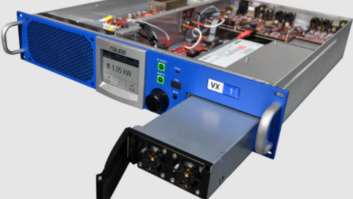This is the time of year to protect transmitter buildings and AM antenna tuning or coupling units from infestation by rodents. Pests can cause no end of engineering nightmares. And it’s just not buildings.
(click thumbnail) Fig. 1 shows the effect of rodents’ sharp teeth on cable.
John White, engineering manager for Crawford’s Portland cluster, had mice in the conduit linking control cabling between his towers. Fig. 1 shows how destructive these pests can be. Those teeth are mighty sharp, and cold weather is not a time to be replacing cable in outside conduit.
John replaced the control cable, then went a step further. He bought some gopher/rat fumigating bombs. He couldn’t put the bombs in the conduit because of their size, and because they would burn the cable. His solution was to improvise a collection canister, seen in Fig. 2. A plastic bucket, hose and duct tape made up the collection canister. The hose was fed into the conduit and plugged with a rag. The bomb was set off, and the lid to the collection canister sealed. The gas was dispersed from the canister to the hose and through the conduit.
The process was completed by plugging each end of the conduit with a wad of steel wool, shown in Fig. 3. Steel wool is a great deterrent to all kinds of vermin, including snakes.
(click thumbnail)Fig. 2: A simple, effective rodent gas chamber.
Save yourself the headache of cleaning up after the damage is done and follow John White’s suggestion.
. . .
Continuing our “mystery cable” discussion of last time:
Steve Savanyu also remembers reading those Shure catalogs in the 1960s, in which the company offered accessory cables to interconnect to devices using twist-lock connectors. After a couple hours of web searching, he came up with the spec sheet for a discontinued Shure mixer, which we told you about.
Why would anyone use this, Steve asks? Talking to a Shure old-timer, he learned that hotel AV departments in the 1960s used Hubble twist lock connectors for mic inputs – ballrooms, banquet rooms, etc. – because they were “indestructible.”
This was also the era when Dukane and Bogen would put male XLR connectors as mic inputs on their mixer and package amplifiers. Because they sold much of this product into schools, the male XLR inputs minimized the potential for connector vandalism by students sticking pencil tips and toothpicks into the female connectors and then breaking them off.
(click thumbnail)Fig. 3: Plug all holes and wire pass-throughs with conduit.
Steve says thanks to Wes Boyd and his crew.
. . .
Chip Morgan of Chip Morgan Broadcast Engineering offered a different take. Based on the large plug style, the color of the zip-tie and the shiny external appearance of the cord, he says our mystery cable was a 1969 “Hum Dinger” cable, sold by Western Electrification company.
This cable was used in the early days of unbalanced solid-state amplifiers to eliminate hum and provide lightning protection. The way it works is that the chassis of the protected equipment is tied directly to the neutral wire of a 220 V twist lock outlet, or, in the case of a remote broadcast, to the 220 V outlet on a portable generator. The center conductor of the RCA plug is isolated from both legs of the 220 V circuit by a two-way spark gap located inside the large plug.
In those days, an engineer would simply plug this jumper cable into every RCA jack in the equipment until the hum stopped, then leave it there, satisfied that the system was now safe and protected from danger. The black tape that was used to re-attach the RCA plug indicates that this cable has done its job (and probably saved a life or two).
You can visit Chip’s web site at www.cmbe.com
. . .
Jeff Hartman, engineering project manager with Clear Channel Television here in the Northeast, add that not too long ago, it was not uncommon to see twist-lock connectors used for mic lines. Jeff’s high school auditorium, circa late 1950s, was set up this way, with twist-lock receptacles on the front of the stage. These were replaced with XLR connectors in the mid-’70s immediately after a classmate plugged a Shure 55SH into a 240V receptacle in the projection room, demonstrating that microphones can generate sound, too … for a little while, at least!
Jeff thinks our cable might have fed a phonograph or tape player into a PA system … or maybe it’s an early prototype for Monster Cable!
. . .
Rick Sedlak is with the Educational Communications Center at Binghamton University. Rick worked in commercial sound for a few years and ran across this type of twist-lock plug a few times. They used the twist-lock jack for microphone jacks. So, it looks like our dead-man’s cable was adapting a microphone plug to an RCA plug.
Thanks to all who commented about the mystery cable. As Steve Savanyu wrote, it was a fun foray into the roots of audio.
. . .
We’re getting neat ideas for our “best circuit” contest. Have you entered? We’re looking for a simple circuit to solve a problem, or modification to equipment that improves its performance. Several cool NAB techie shirts – in addition to a Workbench stipend – go to the best designs.
E-mail or fax your submission, with a clearly drawn schematic and parts list. Your submission will also qualify for SBE recertification credit.















